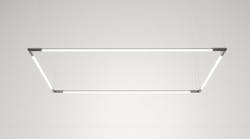Lighting plays a vital, yet sometimes overlooked, role in the transformation of an interior space. While a fixture may be aesthetically perfect in a room, failing to take into account the light it radiates can create bigger issues. “Traditionally some luminaires and lighting schemes have been designed from an aesthetic standpoint, with form arguably coming before function, or from a regulatory one, to ensure that they tick the boxes of regulations,” said Sam Bernard, Global Category director for Dyson Professional. “But this approach can leave the end user out of the picture, with problems such as glare from exposed light sources or a uniform blanket of light ‘bleaching out’ spaces.”
Robert Sonneman, CEO of SONNEMAN, stated, “Lighting is the universally essential element in any space, defining visibility and the emotional response to an environment. Critical attention to lighting design is essential to directing attention to key areas and focal points, receding less critical areas from the priority of view.
“The lighting scheme should be integral to the project scheme from first concept,” he added.
First Steps: When approaching a new project, pay special attention to where light and shadows exist throughout the day, and what the room will be used for. “Consider how the products will help achieve the type of light that will be optimum for the occupants of their space and their activities,” Bernard said. “It’s also important to consider whether the lighting scheme will offer flexibility for spaces which are used in different ways at different times throughout the day.” If possible, view the space during different times of day, taking note of how light filters through the windows throughout. Also keep in mind that the sun moves in the sky according to season—a space that provides nice natural light during the winter can be glaring in the summer.
Keep Wattage in Mind: Despite choosing a stunning lighting fixture for your design, not paying attention to the wattage can create lighting challenges. “An architect or designer could be picking out a 200 watt beautiful, decorative chandelier, but it’s going to be over the watts required for that specific room type,” said Lauren Roberts, LC, EDAC, IES, Healthcare Market Development manager for Visa Lighting. “In certain spaces, like corridors, decorative lighting is going away because you’re only allowed a certain watt per square foot. It’s hard to get to that wattage with decorative fixtures.”
Roberts’ suggestion: “If you’re meeting your wattage required and have a little extra room, then you should put in decorative lighting, but they have to work together with the functional lighting that’s needed in each space.”
Lighting has a Significant Effect on Health: “People are now starting to recognize that light is effectively a drug,” Bernard said. “It can directly influence your physical and mental wellbeing.” For Dyson, the future of lighting lies in wellness. Nav Sooch, CEO of Ketra, a natural light and integrated control system company, and Shant Madjarian of Juniper Lighting agree on this. “There is technology that can change the temperature of the lights in response to the time of day,” Madjarian explained. “This can help improve productivity and mental health by matching ambient light with our natural circadian rhythm.”
Sooch added, “Lighting impacts our health and enjoyment of a space more than just about any other factor.” Throughout the day, natural lighting provides a spectrum of wavelengths, resulting in subtle changes in color: Light in the middle of the day contains more blue energy, while it is more orange at night.
However, because of an increase of screens in our environment—which emit a blue light—circadian lighting is important in helping us wind down at the end of the day. “You need blue light to be taken away so your body starts producing melatonin to allow you to rest,” he noted. The Circadian Stimulus Score (CS Score) was created to more easily determine how well a lighting source is able to simulate natural lighting.
Color Temperature Sets the Tone: In addition to the importance of light color to one’s health, specifying the correct color temperature for a space sets the tone and can eliminate any issues in visibility. “You wouldn’t do an exam room in a warm light because you lose visual acuity when you’re trying to see the patient,” Roberts said. “However, you would want to use warm light in family areas, waiting spaces, places like that.”
Madjarian added that one downside of integrating new lighting technologies is that, when color is disregarded, it can look too uptight. “It is important to note that technology should not, and does not, substitute good design, nor should lighting that adopts new technology feel techy or sterile,” he explained. “This actually presents an opportunity for us in the design industry to combine craft and Old World influences with the technologies that are guiding the industry to create functional lighting with a strong underlying aesthetic narrative.”
PageBreakInclude the Color Rendering Index: Although the light emitted from a fixture can set the tone or aid circadian rhythm with its color, that doesn’t necessarily mean that things will look right in a space. For example, if restaurant patrons have to constantly squint to see a menu, or end users find their skin tone a little green, the Color Rendering Index (CRI) could be off. “It’s not just the color temperature; it’s also how well the light source renders the color of an object,” Roberts said. “You can have a warm color temperature, but it will render colors in the room just awfully. Incandescent is a warm color temperature that has a nearly perfect CRU capability, which is good for those two things, but it uses 100 watts, which is why we don’t use incandescent anymore. You have to balance color temperature with CRI and wattage.”
Be Aware of Limitations: “The lighting industry is undergoing disruption with the advent of LED technology, but the shift as it relates to energy efficiency and new design possibilities is a big positive,” Madjarian explained. “But like all change, it brings challenges as the industry learns to cope with the new realities.”
One of the mistakes designers make, particularly in custom lighting design, is believing that LEDs are limitless. It’s easy to get excited about new forms LEDs allow for, but heat dissipation and low-voltage power management create boundaries to what LEDs can accomplish. Bernard pointed to the use of heat pipes to allow proper cooling of LED chips. Designers should remember that although we’re used to LEDs not giving off the same type of heat as other lights, there are hidden mechanisms that need to be built into the fixture to allow for heat dissipation.
Another set of limitations: the life of the LED. While LEDs are required to achieve at least 50,000 hours without lumen depreciation, and companies such as Dyson boast 180,000 hours of consistent quality, Madjarian said to keep longevity in mind. “What happens to the fixture in 10 or 20 years when the LEDs begin to fail? This is a legitimate concern. I would first recommend that designers and specifiers consider matching the expected longevity of the integrated LED with that of the expected life of the project. Apart from LED retrofit bulbs, LED modules in light fixtures are not meant to be replaced.”
A positive: As technology is consistently changing, the lifespan of LEDs is getting longer and longer.
Feel Free to Ask Your Reps for Help: While the easiest way to ensure a project’s lighting is up to snuff is to work with a lighting engineer, those with smaller budgets should feel free to reach out to lighting reps with their project concerns. “I would recommend talking to your rep more,” Roberts said. “A lot of reps do know what they’re doing. Especially if you don’t have an engineer, go over your layout with the rep.”
Sonneman agreed. “The professional designers and architectural firms that seek our contribution to their designed spaces generally have selected luminaires from our line, then ask us to suggest which one we feel is most appropriate and effective for the intended installation,” he explained.
Where Lighting is Headed: Across the board, these experts agreed that the future of lighting is in emerging LED technology—such as OLEDs and bendable LEDs, which allow evolving forms—but integrated systems are of particular note. “‘Smart lighting’ is becoming the clear leader in driving the future of the industry,” Madjarian said. “To be clear, smart lighting is not exactly new. Digital centralized lighting controls have been around for a while, but it is the advent of wireless controls and applications coupled with [LEDs] that open up a world of possibilities.”
Sonneman noted that this evolution in lighting has only just begun. “We are only at the beginning of electronic illumination becoming an infinitely diverse medium for innovation and change. The future is integration of systems that manage all aspects of the built environment. Electronic illumination will manage our circadian rhythm; color tuning will adjust our mood and perception of people and places; and the heat energy—uselessly discharged—will now provide our ubiquitous Wi-Fi. LED illumination will grow our food and clean our air.”
While that last prediction seems a little far in the future, and “there’s an app for that” lighting controls are already advertised everywhere, suspended light fixtures are already being used as optimal wireless hubs, and the trend shows no signs of stopping.

